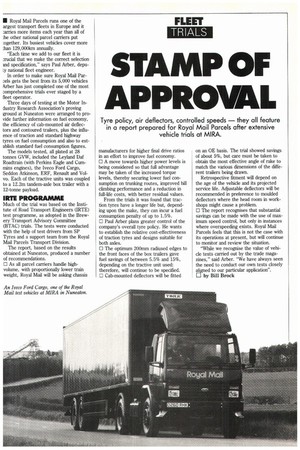STAMP OF APPROVAL
Page 23

If you've noticed an error in this article please click here to report it so we can fix it.
• Royal Mail Parcels runs one of the argest transport fleets in Europe and it carries more items each year than all of he other national parcel carriers put :ogether. Its busiest vehicles cover more than 129,000km annually.
"Each time we add to our fleet it is cnicial that we make the correct selection and specification," says Paul Arber, deputy national fleet engineer.
In order to make sure Royal Mail Parcels gets the best from its 5,000 vehicles Arber has just completed one of the most comprehensive trials ever staged by a fleet operator.
Three days of testing at the Motor Industry Research Association's proving ground at Nuneaton were arranged to provide further information on fuel economy, the efficiency of cab-mounted air deflectors and contoured trailers, plus the influence of traction and standard highway tyres on fuel consumption and also to establish standard fuel consumption figures.
The models tested, all plated at 28 tonnes GVW, included the Leyland Daf Roadtrain (with Perkins Eagle and Cummins engines), the Iveco Ford Cargo, Seddon Atkinson, ERF, Renault and Volvo. Each of the tractive units was coupled to a 12.2m tandem-axle box trailer with a 12-tonne payload.
IRTE PROGRAMME
Much of the trial was based on the Institute of Road Transport Engineers (IRTE) test programme, as adopted in the Brewery Transport Advisory Committee (BTAC) trials. The tests were conducted with the help of test drivers from SP Tyres and a support team from the Royal Mail Parcels Transport Division.
The report, based on the results obtained at Nuneaton, produced a number of recommendations.
0 As all parcel carriers handle highvolume, with proportionally lower train weight, Royal Mail will be asking chassis manufacturers for higher final drive ratios in an effort to improve fuel economy. 0 A move towards higher power levels is being considered so that full advantage may be taken of the increased torque levels, thereby securing lower fuel consumption on trunking routes, improved hill climbing performance and a reduction in full-life costs, with better residual values.
From the trials it was found that traction tyres have a longer life but, depending upon the make, they can incur a fuel consumption penalty of up to 1.5%. 0 Paul Arber plans greater control of the company's overall tyre policy. He wants to establish the relative cost-effectiveness of traction tyres and designs suitable for both axles.
0 The optimum 200mm radiused edges to the front faces of the box trailers gave fuel savings of between 5.5% and 15%, depending on the tractive unit used: therefore, will continue to be specified.
Cab-mounted deflectors will be fitted on an OE basis. The trial showed savings of about 5%, but care must be taken to obtain the most effective angle of rake to match the various dimensions of the different trailers being drawn.
Retrospective fitment will depend on the age of the vehicle and its projected service life. Adjustable deflectors will be recommended in preference to moulded deflectors where the head room in workshops might cause a problem.
0 The report recognises that substantial savings can be made with the use of maximum speed control, but only in instances where overspeeding exists. Royal Mail Parcels feels that this is not the case with its operations at present, but will continue to monitor and review the situation.
"While we recognise the value of vehicle tests carried out by the trade magazines," said Arber. "We have always seen the need to conduct our own tests closely a-14 ed to our particular application". IU by Bill Brock




























































